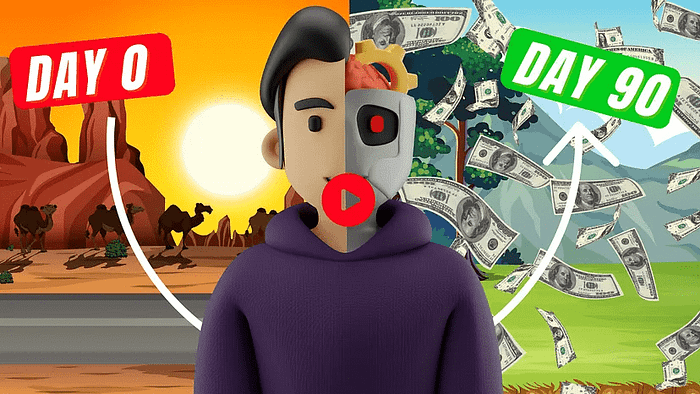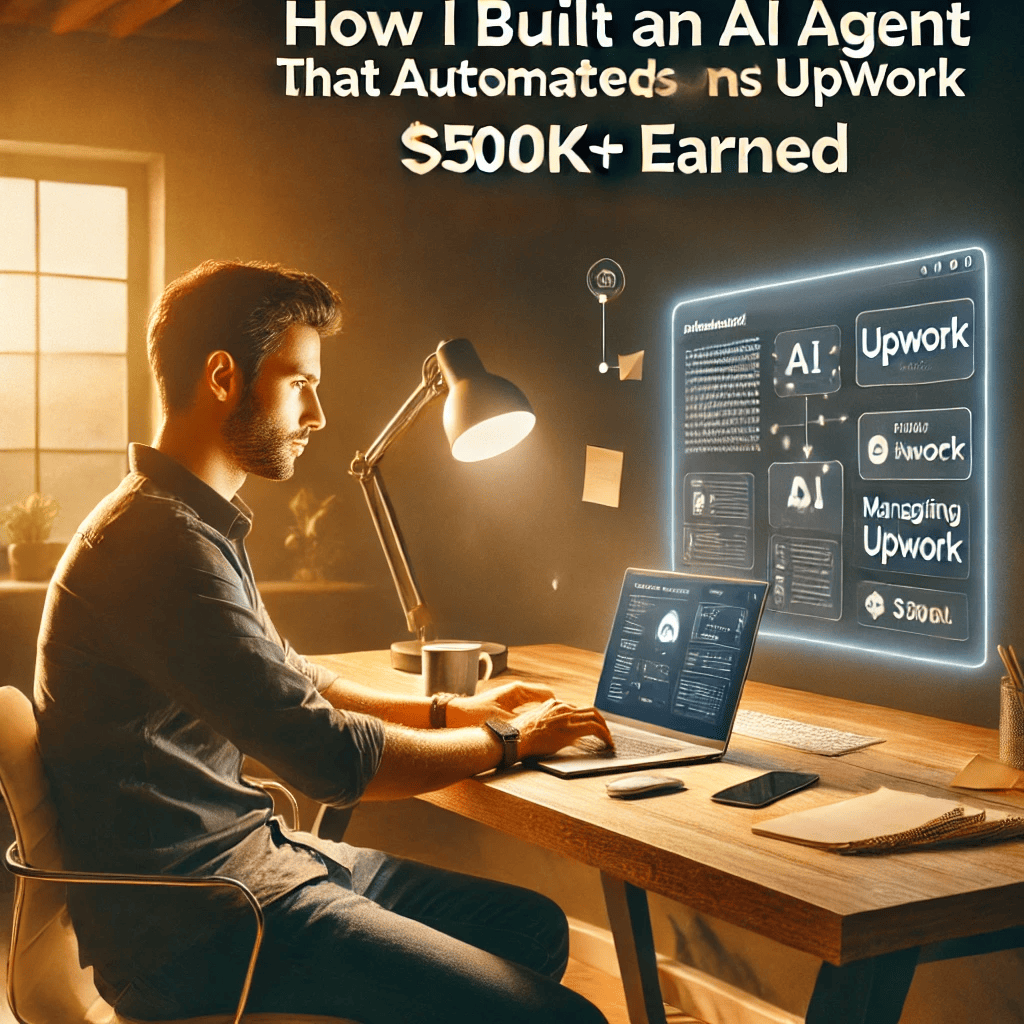How I Built An AI Agent That Automates Upwork Applications ($500K+ Earned)
I built an AI agent that automates Upwork job applications after earning over $500K on the platform through years of testing strategies and optimizing approaches. After analyzing hundreds of successful proposals, I’ve identified that the main distinguishing factors in high-performing Upwork applications are the degree of perceived customization and perceived value. This insight led me to develop an AI agent that produces both elements at scale, saving hours of work while maintaining exceptional quality.
The system operates by exposing a chat window where I can paste an Upwork job posting. The agent then processes this information through three specialized sub-flows, each generating different assets that collectively create a comprehensive, customized application package. This approach has revolutionized my freelance business operations and significantly increased my success rate.
Throughout my experience working on the platform, I’ve consistently refined my approach to proposal writing, client communication, and project delivery. The accumulated knowledge from these experiences forms the foundation of the AI system I’ve developed, encoding best practices that took years to discover through trial and error.
We strongly recommend that you check out our guide on how to take advantage of AI in today’s passive income economy.
Table of Contents
The AI Agent Workflow Architecture
The workflow operates through a primary agent that coordinates three distinct sub-processes. Once I paste a job description into the system, these processes activate sequentially to produce a complete application package. The architecture resembles a typical AI agent system, with a chat interface that processes input and then intelligently routes tasks to specialized sub-flows.
When building this system, I deliberately separated the workflow into three distinct sub-processes rather than creating one massive flow. This modular approach allows each component to excel at its specific task, which is particularly important when working with models like GPT-4. The more focused and specific the instructions, the better the output quality.
For AI models, context management is crucial. By dividing tasks into specialized modules, I ensure each component receives only the most relevant instructions. This approach minimizes confusion and maximizes performance, resulting in higher quality outputs across all generated assets.
The first sub-flow generates a customized Upwork proposal response. This text forms the core of what potential clients see first when reviewing applications. The second creates a professional Google Doc proposal with detailed project plans and approach. The third generates a visual workflow diagram using mermaid notation, which provides an immediate visual demonstration of process understanding.
Creating the Application Copy Generator
The first component of my system automates the creation of personalized application copy. This text appears directly in the Upwork proposal and serves as the initial point of contact with potential clients. The quality of this copy can determine whether a client continues to review additional materials or moves on to the next applicant.
For this component, I created a prompt structure that begins with contextual information about who I am and the specific task I want to accomplish. The prompt then provides a template structure that the AI uses as a framework, with variables the model fills in based on the job description. This template-based approach ensures consistency while allowing for customization.
One key insight I’ve incorporated into my prompt engineering philosophy is to have AI generate only specific portions of otherwise templated content. This provides the flexibility and personalization of AI while maintaining the reliability and predictability that business applications require. The vast majority of the text remains consistent, with the AI adding targeted customizations based on the specific job requirements.
The template includes strategic elements designed to increase engagement and response rates. For example, I explicitly mention that I’ve created custom assets specifically for the client, which demonstrates both interest and capability. I also include a reminder that the client needs to respond to establish communication, which has significantly increased my response rates on the platform.
Rather than relying solely on AI creativity, I’ve designed the system to leverage proven templates with strategic AI-driven customizations. This balances reliability with personalization, creating proposals that feel custom-crafted while maintaining consistent quality and messaging across all applications.
Building the Google Doc Proposal Generator
The second component generates a professional Google Doc proposal that provides detailed information about my approach to the client’s project. This document serves as a more comprehensive follow-up to the initial application, demonstrating thoroughness and attention to detail that sets me apart from competitors.
The workflow begins by copying a template Google Doc that I’ve refined over years of successful proposals. Using the Google Drive API, the system creates a copy of this template and sets appropriate sharing permissions to ensure clients can access it. The document title dynamically updates to reflect the specific project being proposed.
The Google Doc follows a carefully structured format that presents information in a clear, professional manner. It includes sections for project overview, approach methodology, implementation steps, and information about my relevant experience. This structure has proven effective across hundreds of client interactions.
Similar to the application copy generator, the Google Doc uses a template-based approach with AI-generated customizations. The AI processes the job description and generates specific content for variables within the document, ensuring the proposal feels tailored to the client’s specific needs while maintaining professional consistency.
The document includes strategic elements like personalized greetings that incorporate the client’s name if available in the job posting. Small details like this significantly impact how clients perceive the proposal, making it feel individually crafted rather than mass-produced. The system handles these customizations automatically.
When preparing the Google Doc, I ensure all permissions are properly set so clients can view but not edit the document. This presentation of a polished, professional document serves as tangible evidence of my capabilities and attention to detail before any conversation even begins.
Implementing the Mermaid Diagram Generator
The third component generates a visual workflow diagram using mermaid notation. This visual asset provides immediate value by illustrating how I would approach the client’s project, demonstrating both understanding and expertise in a format that’s quickly digestible and impressive.
For those unfamiliar with mermaid, it’s a JavaScript-based diagramming and charting tool that renders markdown-inspired text definitions into diagrams. Using simple syntax, it can create flowcharts, sequence diagrams, gantt charts, and other visualizations that effectively communicate process flows.
The mermaid generator analyzes the job description and creates appropriate flowchart code that visualizes a potential solution to the client’s needs. By constraining the output to specifically generate flowcharts rather than other diagram types, I ensure consistency and reliability in the visual assets produced.
The resulting diagram code can be pasted into various visualization tools or directly into platforms that support mermaid rendering. This provides a professional-looking workflow diagram that appears to have required significant effort to create, though it’s generated automatically by the system.
While it would be possible to extend this functionality to automatically render the diagram and capture a screenshot, I’ve found the current approach hits the sweet spot of efficiency and effectiveness. The diagram code provides significant perceived value while requiring minimal processing resources.
When clients receive these visual workflows, they perceive a level of effort and customization that sets my applications apart. The diagrams effectively communicate complex processes in an accessible format, demonstrating both technical knowledge and communication skills simultaneously.
Integrating the Complete AI Agent System
With all three components functioning independently, the final step was to integrate them into a cohesive system under the control of a primary AI agent. This agent serves as the coordinator, intelligently routing the job description to each sub-process and combining their outputs into a complete application package.
The system uses window buffer memory to maintain context throughout the conversation, allowing it to reference previous interactions when generating responses. This creates a more coherent experience and enables the agent to build upon information gathered throughout the process.
When setting up the primary agent, I used a system message that defines its purpose and capabilities, essentially telling it: “You’re a helpful intelligent assistant tasked with receiving an Upwork job description and generating assets like mermaid diagrams, Google Docs, and application bodies.” This instruction sets the expectations for how the agent should behave.
I connected the agent to the appropriate AI model and configured it to call the three sub-workflows as tools. Each tool receives specific instructions about its purpose, input requirements, and expected output format. This structured approach ensures the agent knows exactly when and how to utilize each component.
The final integration included specific instructions for how the agent should handle the complete workflow. Rather than requiring manual requests for each asset, I configured the system to automatically generate all three assets whenever a job description is provided, streamlining the process further.
Additionally, I included logic to have the agent replace placeholder text in the application copy with the actual Google Doc URL, creating a seamless connection between the different assets. This ensures all components work together cohesively in the final application package.
Prompt Engineering for Optimal Results
Throughout the development of this system, effective prompt engineering proved crucial to achieving consistently high-quality outputs. The prompts I developed follow a specific structure designed to maximize performance while maintaining reliability across various job types.
Each prompt begins with context about who I am and what I’m trying to accomplish. This grounds the AI in the specific use case and provides necessary background information. Next comes a clear task definition that specifies exactly what input the model will receive and what output it should produce.
After establishing context and task, I provide explicit examples of the desired output format. Rather than relying on abstract instructions, I show the model exactly what I want, complete with placeholders that indicate where customization should occur. This dramatically improves output consistency.
Following the examples, I include specific rules and formatting requirements. These constraints guide the model’s generation process, ensuring outputs adhere to necessary standards. For the mermaid diagram generator, for instance, I specify that it should only produce flowcharts, not sequence diagrams or gantt charts.
I’ve found that structuring prompts as numbered lists or bullet points significantly improves adherence to instructions. Similarly, providing output format specifications using concrete examples rather than abstract descriptions results in more consistent, usable outputs.
Temperature settings also play an important role in output quality. Through experimentation, I’ve found that a temperature of 0.7 produces outputs that better match my preferred tone while maintaining appropriate professionalism. These settings may vary based on personal preference.
Scaling and Customization Considerations
While this system provides significant efficiency improvements, I recommend customizing templates and approaches rather than using the exact configurations I’ve developed. As more people adopt similar automation strategies, differentiation becomes increasingly important to maintain effectiveness.
The modular nature of this system allows for easy customization and extension. You could add additional components that scrape Upwork for relevant jobs, filter opportunities based on specific criteria, or even automate parts of the application submission process, though platform terms of service should always be considered.
For personal customization, I recommend modifying the “about me” sections and social proof examples to accurately reflect your own experience and achievements. The system includes variables specifically designed to facilitate these customizations without requiring changes to the underlying workflow logic.
When implementing this system for yourself, consider your unique value proposition and how to effectively communicate it through automated systems. While the structure may remain similar, the specific content should reflect your individual skills, experience, and target client base.
It’s worth noting that as platforms evolve, they may implement measures to detect and discourage excessive automation. However, as a systems builder or automation specialist, your ability to create efficient processes demonstrates precisely the skills most clients are seeking. The key is balancing automation with authentic value delivery.
Balancing Automation with Authenticity
Throughout my experience building and using this system, I’ve maintained a focus on balancing efficiency through automation with authentic value delivery. The goal isn’t to trick clients or create generic applications en masse, but rather to scale personalized, high-quality interactions.
The approach I’ve developed relies heavily on templating most content while using AI to generate specific, contextually relevant customizations. This ensures consistency and reliability while still providing the personalization clients expect. It’s about working smarter, not cutting corners.
For each application, I recommend reviewing the generated content and making minor adjustments as needed. While the system produces high-quality outputs, human oversight ensures everything aligns with your personal brand and the specific opportunity. This hybrid approach maximizes efficiency while maintaining authenticity.
I’ve also found that being transparent about my approach to systemization and automation has actually strengthened client relationships. At the beginning of engagements, I explain that my goal is to establish long-term partnerships and that everything we build together serves as foundation for ongoing value delivery. This upfront communication sets appropriate expectations.
The success of this approach is evident in the results—over $500K earned on Upwork and numerous long-term client relationships established. The system doesn’t replace the need for expertise or quality delivery; it simply removes administrative friction that prevents top performers from connecting with ideal clients.
Conclusion
Building an AI agent that automates Upwork applications has transformed my freelance business operations and significantly improved my success rate on the platform. By focusing on the two key factors that differentiate successful applications—perceived customization and perceived value—I’ve created a system that delivers both at scale.
The modular architecture, with its primary agent coordinating three specialized sub-processes, provides flexibility and consistent performance across various job types. Each component—application copy generator, Google Doc proposal creator, and mermaid diagram generator—delivers specific value that collectively creates compelling application packages.
Effective prompt engineering serves as the foundation of this system, with carefully structured instructions that balance AI flexibility with business predictability. The approach of templating most content while using AI for targeted customizations delivers the best of both worlds—consistency and personalization.
As you implement similar systems for your own freelance business, remember to customize templates and approaches to reflect your unique value proposition. The automation itself demonstrates precisely the skills most clients seek when hiring systems builders and automation specialists.
The freelance landscape continues to evolve, with increasing competition and platform sophistication. However, those who effectively leverage technology to scale personalized interactions will maintain a significant advantage. This AI agent system represents just one example of how intelligent automation can transform freelance operations and outcomes.

We strongly recommend that you check out our guide on how to take advantage of AI in today’s passive income economy.




